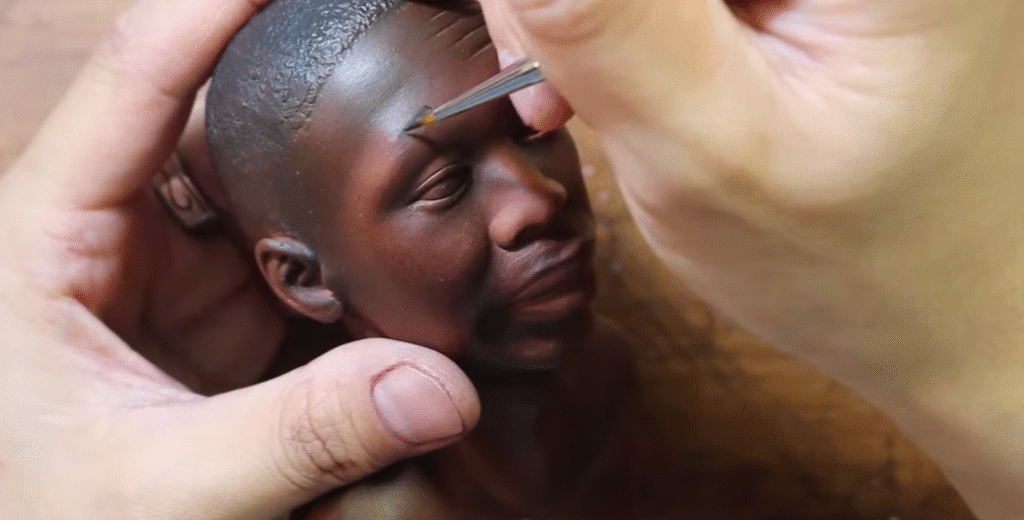The story of the Khaby Lame Mechanism’s ascent is remarkably unique and aptly illustrates the ways in which humor, technology, and human mimicry have become a part of contemporary cultural expression. What started out as a straightforward do-it-yourself robot has evolved into a representation of irony and the potential for both celebration and endless replication of digital celebrity.
Korean YouTuber ATMUMAN constructed the low-tech device known as the “Khaby Lame Mechanism,” which he posted online in 2021 under the title “Making Khaby Lame Robot.” A printout of Khaby’s expressionless face is placed on top of a machine that he is seen meticulously assembling using a chain-driven motor. The device has rotating arms that slap a table in a rhythmic manner. The mechanism, which is both spooky and humorous, is a very successful adaptation of Lame’s famous silence.
A modest creative endeavor quickly grew into something much bigger. In 2021, Redditors rediscovered the video and posted it on r/shittyrobots, which sparked its gradual spread on social media. Two years later, it was brought back to life by TikTok users who paired it with Tyler, The Creator’s melancholic song “Yonkers.” This remix turned the video into a viral meme, and the robot—now known as the “Khaby Lame Mechanism”—became the newest cultural mascot on the internet.
Khaby Lame — Personal & Professional Overview
| Category | Information |
|---|---|
| Full Name | Khabane “Khaby” Lame |
| Birth Date | March 9, 2000 |
| Birthplace | Dakar, Senegal |
| Nationality | Italian (naturalized) |
| Profession | Content Creator, Comedian, Influencer |
| Known For | Silent reaction videos mocking complicated “life hacks” |
| Social Media | TikTok, Instagram, YouTube |
| Net Worth (Est.) | Over $15 million |
| Awards | TikTok Creator of the Year, Cannes Lions Social Impact Honoree |
| Reference | Wikipedia – Khaby Lame |

The meme’s premise is delightfully ridiculous: After committing a mistake or moral “sin,” a person is punished by being permanently transformed into the Khaby Lame Mechanism, which is destined to always make his signature shrug. This metaphor feels especially insightful about the nature of digital repetition, despite being humorous. Online celebrity is not static; rather, it is cyclical, and creators frequently find themselves caught in a never-ending cycle of their own personas.
The humor is effective because it is eerie. The monotonous repetition of the robot makes one think of the weariness of performing online all the time. Our habits of overconsumption and imitation seem to be reflected in an overly ideal mirror created by the internet. Every meme, remix, and share turns individuality into a machine. Once a silent protest against overcomplication, Khaby Lame’s iconic shrug now recurs endlessly in mechanical form, devoid of spontaneity but immortalized by it.
Given his reputation for being incredibly composed and modest, Khaby himself seems like a good candidate for this paradox. All of his success comes from doing less, such as making simple gestures, saying nothing, and making common sense appear revolutionary. A mechanical reflection on the peculiar permanence of fame, The Mechanism takes that simplicity and extends it to infinity.
Because the Khaby Lame Mechanism blurs the line between prophecy and parody, cultural observers have found it especially fascinating. In a highly automated digital environment, this machine embodies the silent fear of creators, much like Charlie Chaplin caught in the gears of Modern Times. Influencers are now templates that are constantly being copied by filters, AI clones, and algorithmic trends rather than merely being human faces.
Stars like Bella Poarch, Addison Rae, and MrBeast have made subtle allusions to the meme, amused but wary of its implications. It alludes to the worry that ultimately, every online personality will be interchangeable—a formula rather than a real person. With its straightforward, repetitive motion, The Mechanism seems to express what many creators secretly think: that once received, viral fame can turn into a prison.
However, the meme is not wholly pessimistic. The way audiences interact with it has a strikingly upbeat quality. Imaginative, playful, and incredibly creative humor persists. Users of TikTok have added more complex scenarios to the joke, such as “working in eternal service to the meme gods” or “seeing the frog that turns you into the Khaby Lame Mechanism.” A vibrant digital imagination that finds delight even in self-satire is reflected in this inventiveness.
The way it showcases the collaborative storytelling capabilities of the internet is also very inventive. A simple YouTube build, ATMUMAN’s original clip has developed into a living story that has been influenced by millions of people. A static invention is transformed into a social art form by each user’s contribution of a line, an edit, a sound, or a caption. It’s comedy as an ecosystem: natural, erratic, and sustained by all.
Khaby Lame’s legacy is further enhanced by the Mechanism. He has, without uttering a single word, sparked a surge in both comedy and creativity. His serene, all-encompassing, and language-neutral expression has evolved into a cultural icon that can be interpreted in countless ways. The robot honors him in motion and spreads his influence into completely new areas rather than making fun of him.
From AI-generated influencers to robotic entertainers, this phenomenon also reflects the growing interest in mechanical mimicry. It gently draws attention to how replication is a topic of fascination for society: how humans and machines mimic one another. At that intriguing nexus, the Khaby Lame Mechanism is both human and artificial, collaborative and individual, handcrafted and algorithmic.

